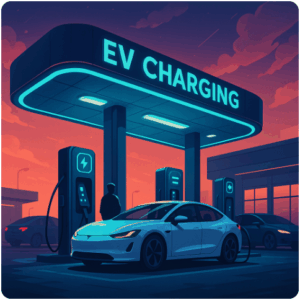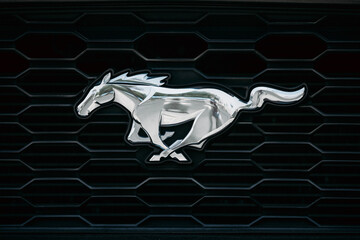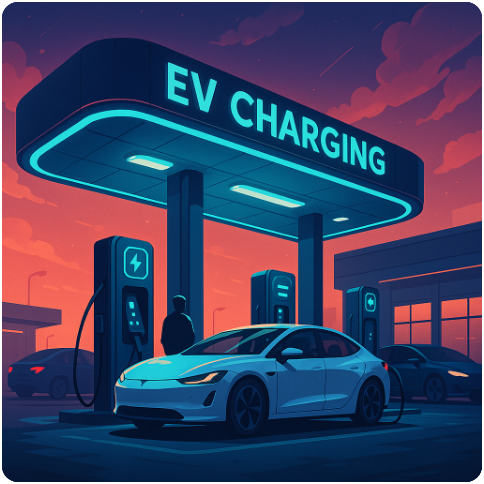Category: Ford Mustang EV
EV Charging May Be Coming to a Gas Station Near You
 Of the many concerns that keep car buyers from taking the plunge into EV ownership, access to fast, on-the-road charging remains at the top of the list. While Tesla has largely solved this problem through its fast charger network, the other 50 percent of EV owners in the U.S. must resort to a hodgepodge of charging pumps, many of which are unreliable, inconveniently located, and take too long to charge.
Of the many concerns that keep car buyers from taking the plunge into EV ownership, access to fast, on-the-road charging remains at the top of the list. While Tesla has largely solved this problem through its fast charger network, the other 50 percent of EV owners in the U.S. must resort to a hodgepodge of charging pumps, many of which are unreliable, inconveniently located, and take too long to charge.
To be sure, the problem is at least partially solved for some EV owners, who can charge their car overnight in their own garage. Yet the problem remains for EV owners that live in townhomes, condominiums, and apartments, without a dedicated garage.
Nouria, a chain of combination gas stations and convenience stores, which operates in more than 180 locations throughout the Northeast, has taken steps to solve the problem. In addition to the typical array of beef jerky sticks available at most gas stations, Nouria goes several steps further, providing an eclectic mix of merchandise, including stuffed animals, Ashton Churchill cigars, healthy snacks, and of course, potato chips and candy bars. As an added convenience, a Dunkin’ Donuts concession provides chocolate glazed, jelly, and butternut donuts, along with blueberry munchkins.
Its filling station in Framingham Massachusetts, located twenty miles from Boston as the crow flies, provides five stalls with two pumps on each side, where up to ten drivers can fill their gas tanks at once. In an accessible area adjacent to the filling pumps reside two ChargePoint Level 3 EV chargers, ready to provide a relatively quick electron boost. Over time, as I’ve routinely stopped for a Dunkin’ butternut donut, I’ve seen Rivian R1Ts, Volkswagen ID.4s, a few Hyundai Ioniq 5s, a couple of Honda Prologues, and several Ford Mustang Mach-Es take their turns in the charging bays.
Recently, I chatted with a couple who were on their way back to their home in Western Massachusetts. They were happy to have found the Nouria station on their Rivian app, which enabled them to charge their R1T pickup truck in something like 20 minutes, though I don’t recall how much range they had left on their battery before stopping at the station. And they didn’t have to drive far out of their way to find it, as the Framingham location is close to the Massachusetts Turnpike entrance. For what it’s worth, they were so enthusiastic about their Rivian that they volunteered to show me the ample trunk space under the front hood, where the engine normally sits in a gas powered pickup truck.
Gas nozzles outweigh EV chargers by a ratio of 5:1 at this particular filling station, yet while on a recent stop, I saw just two cars filling up for gas, while both chargers were occupied. As I washed down my Dunkin munchkin with a swig of coffee, I thought: could this be a glimpse into the future?
Less than two percent of all cars in Massachusetts are EVs, but EVs now account for 12 percent of all new cars purchased in the state, according to the Alliance for Automotive Information. Nouria has placed a bet that the numbers will rise, and perhaps over time more EV chargers will be added to more of its locations. In the meantime it will be interesting to see if others in the convenience store and gas station business begin to add EV chargers. The pace of EV adoption and demand for charging services will no doubt dictate the decision.
It’s Time for a Real Mustang EV
 The resounding box office success of Top Gun: Maverick, in which Tom Cruise reprises his role as fighter pilot Pete “Maverick” Mitchell, is the most recent example of America’s love of nostalgia. Despite the nearly forty year interval between the two films, diehard fans of the original Top Gun and new filmgoers alike were enticed to return to the big screen.
The resounding box office success of Top Gun: Maverick, in which Tom Cruise reprises his role as fighter pilot Pete “Maverick” Mitchell, is the most recent example of America’s love of nostalgia. Despite the nearly forty year interval between the two films, diehard fans of the original Top Gun and new filmgoers alike were enticed to return to the big screen.
The Ford Motor Company has a similar opportunity to revisit the phenomenal success of the original Mustang, a two-door sports car that sold over one million units in its first two years. Named after the World War II fighter plane, and launched at the New York World’s Fair in 1964, what came to be known as the “pony car” combined the best of European styling and American ingenuity. In the new age of EVs, Ford has launched the Mustang Mach-E SUV, which carries the Mustang moniker, but, let’s face it, in no way resembles the original.
To be sure, Ford has taken strong steps to electrify its product line, as evidenced by MotorTrend’s recent unanimous selection of the Ford F-150 Lightning as Truck of the Year for 2023. But why not create a real Mustang EV, similar in body design to the one that captured the imagination of a generation of car-buyers. An authentic looking and performing Mustang would give Ford the chance to create a “two-horse” race with Tesla, whose Model 3 is the early leader in the EV passenger car category. By doing so, Ford would be making a statement that it will not cede this all-important segment as the world shifts from combustion engines to electric motors.
Rather than compete solely on the basis of safety features and battery range, Ford could bring back the original pony interior, with its alluring three-dimensional image of horses in flight. Rivian Automotive has made a minor splash in the pickup truck world with its vegan leather interior, an obvious appeal to the environmentally conscious. With vinyl records making a comeback, Ford could bring back the original vinyl interior of the Mustang, or perhaps an engineered material which does not bake or crack in the sun? And as much as many of us enjoy the utter silence of an EV motor, Ford could embed a device that simulates the growl of the Mustang engine, an option for traditional automotive enthusiasts.
And who knows? An EV incarnation of the original Mustang might be even more successful than the original. After all, the new Top Gun: Maverick achieved a 96 percent approval rating on Rotten Tomatoes, while its predecessor tallied a mere 58 percent. So too does Ford have the opportunity to create an even more popular Mustang that would reach a wider audience in a new era of consumer transportation.

